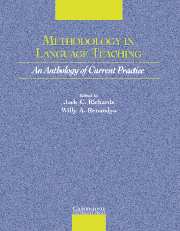Book contents
- Frontmatter
- Contents
- Acknowledgments
- Introduction
- Section I Approaches to Teaching
- Section 2 Lesson Planning and Classroom Management
- Section 3 Classroom Dynamics
- Section 4 Syllabus Design and Instructional Materials
- Section 5 Task and Project Work
- Section 6 Learning Strategies
- Section 7 Teaching Grammar
- Section 8 Teaching Pronunciation
- Section 9 Teaching Speaking
- Section 10 Teaching Listening
- Section 11 Teaching Vocabulary
- Chapter 24 Current Research and Practice in Teaching Vocabulary
- Chapter 25 Best Practice in Vocabulary Teaching and Learning
- Section 12 Teaching Reading
- Section 13 Teaching Writing
- Section 14 Assessment
- Section 15 Technologies in the Classroom
- Section 16 Professional Development
- Credits
- Author Index
- Subject Index
- References
Chapter 24 - Current Research and Practice in Teaching Vocabulary
Published online by Cambridge University Press: 10 November 2010
- Frontmatter
- Contents
- Acknowledgments
- Introduction
- Section I Approaches to Teaching
- Section 2 Lesson Planning and Classroom Management
- Section 3 Classroom Dynamics
- Section 4 Syllabus Design and Instructional Materials
- Section 5 Task and Project Work
- Section 6 Learning Strategies
- Section 7 Teaching Grammar
- Section 8 Teaching Pronunciation
- Section 9 Teaching Speaking
- Section 10 Teaching Listening
- Section 11 Teaching Vocabulary
- Chapter 24 Current Research and Practice in Teaching Vocabulary
- Chapter 25 Best Practice in Vocabulary Teaching and Learning
- Section 12 Teaching Reading
- Section 13 Teaching Writing
- Section 14 Assessment
- Section 15 Technologies in the Classroom
- Section 16 Professional Development
- Credits
- Author Index
- Subject Index
- References
Summary
INTRODUCTION
The purpose of this article is to present a systematic framework for vocabulary development by combining three approaches to vocabulary instruction and learning (modified from Coady, 1997a; Hulstijn, Hollander, & Greidanus, 1996). These three approaches – incidental learning, explicit instruction, and independent strategy development – are presented in this article as seven teaching principles. The incidental learning of vocabulary requires that teachers provide opportunities for extensive reading and listening. Explicit instruction involves diagnosing the words learners need to know, presenting words for the first time, elaborating word knowledge, and developing fluency with known words. Finally, independent strategy development involves practicing guessing from context and training learners to use dictionaries.
Although all of these approaches and principles have a role to play in vocabulary instruction, the learners' proficiency level and learning situation should be considered when deciding the relative emphasis to be placed on each approach. In general, emphasizing explicit instruction is probably best for beginning and intermediate students who have limited vocabularies. On the other hand, extensive reading and listening might receive more attention for more proficient intermediate and advanced students. Also, because of its immediate benefits, dictionary training should begin early in the curriculum.
Before proceeding, it is necessary to clarify the definition of a word. In this article, a word (also called a base word or a word family) is defined as including the base form (e.g., make) and its inflections and derivatives (e.g., makes, made, making, maker, and makers).
Information
- Type
- Chapter
- Information
- Methodology in Language TeachingAn Anthology of Current Practice, pp. 258 - 266Publisher: Cambridge University PressPrint publication year: 2002
References
Accessibility standard: Unknown
Why this information is here
This section outlines the accessibility features of this content - including support for screen readers, full keyboard navigation and high-contrast display options. This may not be relevant for you.Accessibility Information
- 22
- Cited by
